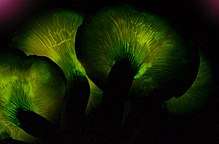Foxfire
Foxfire, also called fairy fire or chimpanzee fire,[1] is the bioluminescence created by some species of fungi present in decaying wood. The bluish-green glow is attributed to a luciferase, an oxidative enzyme, which emits light as it reacts with a luciferin. The phenomenon has been known since ancient times, with its source determined in 1823.
 Panelluses stipticus, Mt. Vernon, Wisconsin (long exposure) | ||
 Omphalotus nidiformis, glowing in the dark  Artificial fill light contrasts against the natural glow. |
Description
Foxfire is the bioluminescence created by some species of fungi present in decaying wood. It occurs in a number of species, including Panellus stipticus, Omphalotus olearius and Omphalotus nidiformis. The bluish-green glow is attributed to a luciferase, an oxidative enzyme, which emits light as it reacts with a luciferin. Some believe that the light attracts insects to spread spores, or acts as a warning to hungry animals, like the bright colors exhibited by some poisonous or unpalatable animal species.[2] Although generally very dim, in some cases foxfire is bright enough to read by.[3]
History
The oldest recorded documentation of foxfire is from 382 B.C., by Aristotle, whose notes refer to a light that, unlike fire, was cold to the touch. The Roman thinker Pliny the Elder also mentioned glowing wood in olive groves.[4]
Foxfire was used to illuminate the needles on the barometer and the compass of Turtle, an early submarine.[5] This is commonly thought to have been suggested by Benjamin Franklin; a reading of the correspondence from Benjamin Gale, however, shows that Benjamin Franklin was only consulted for alternative forms of lighting when the cold temperatures rendered the foxfire inactive.
After many more literary references to foxfire by early scientists and naturalists, its cause was discovered in 1823. The glow emitted from wooden support beams in mines was examined, and it was found that the luminescence came from fungal growth.[6]
The "fox" in "foxfire" may derive from the Old French word fols, meaning "false", rather than from the name of the animal.[7] The association of foxes with such fires is widespread, however, and occurs also in Japanese folklore.
See also
- List of bioluminescent fungi
- Will-o'-the-wisp
- Aurora Borealis, called "revontulet" (literally "foxfires") in the Finnish language
References
- "Congo". Africa. January 16, 2013. BBC One.
- "Foxfire:Bioluminescent Fungi". inamidst.com. Retrieved July 18, 2011.
- "Bioluminescent Fungi". Mykoweb. Retrieved July 18, 2011.
- "Foxfire: Bioluminescence in the Forest". Warnell School of Forest Resources. Archived from the original on July 19, 2011. Retrieved July 18, 2011.
- "The Submarine Turtle: Naval Documents of the Revolutionary War". Navy Department Library. Archived from the original on September 17, 2008. Retrieved May 1, 2012.
- "Bioluminescent foxfire, Bioluminescence facts, Bioluminescent fungi". Journey Idea. Retrieved July 18, 2011.
- Smythe Palmer, Abram, The Folk and Their Word-lore: An Essay on Popular Etymologies (1904)
External links
| Look up foxfire in Wiktionary, the free dictionary. |
- Foxfire: Bioluminescence in the Forest pdf file by Dr. Kim D. Coder, University of Georgia 8/99
- Bioluminescent Fungi at Mykoweb
